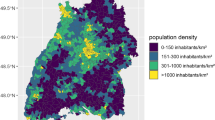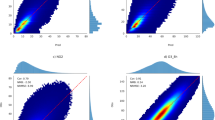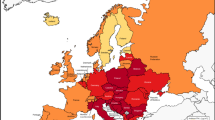Abstract
Associations of particulate matter (PM) and ozone with morbidity and mortality have been reported in many recent observational epidemiology studies. These studies often considered other gaseous co-pollutants also as potential confounders, including nitrogen dioxide (NO2), sulfur dioxide (SO2), and carbon monoxide (CO). However, because each of these air pollutants can have different seasonal patterns and chemical interactions, the estimation and interpretation of each pollutant's individual risk estimates may not be straightforward. Multi-collinearity among the air pollution and weather variables also leaves the possibility of confounding and over- or under-fitting of meteorological variables, thereby potentially influencing the health effect estimates for the various pollutants in differing ways. To investigate these issues, we examined the temporal relationships among air pollution and weather variables in the context of air pollution health effects models. We compiled daily data for PM less than 2.5 μm (PM2.5), ozone, NO2, SO2, CO, temperature, dew point, relative humidity, wind speed, and barometric pressure for New York City for the years 1999–2002. We conducted several sets of analyses to characterize air pollution and weather data interactions, to assess different aspects of these data issues: (1) spatial/temporal variation of PM2.5 and gaseous pollutants measured at multiple monitors; (2) temporal relationships among air pollution and weather variables; and (3) extent and nature of multi-collinearity of air pollution and weather variables in the context of health effects models. The air pollution variables showed a varying extent of intercorrelations with each other and with weather variables, and these correlations also varied across seasons. For example, NO2 exhibited the strongest negative correlation with wind speed among the pollutants considered, while ozone's correlation with PM2.5 changed signs across the seasons (positive in summer and negative in winter). The extent of multi-collinearity problems also varied across pollutants and choice of health effects models commonly used in the literature. These results indicate that the health effects regression need to be run by season for some pollutants to provide the most meaningful results. We also find that model choice and interpretation needs to take into consideration the varying pollutant concurvities with the model co-variables in each pollutant's health effects model specification. Finally, we provide an example for analysis of associations between these air pollutants and asthma emergency department visits in New York City, which evaluate the relationship between the various pollutants' risk estimates and their respective concurvities, and discuss the limitations that these results imply about the interpretability of multi-pollutant health effects models.
This is a preview of subscription content, access via your institution
Access options
Subscribe to this journal
Receive 6 print issues and online access
$259.00 per year
only $43.17 per issue
Buy this article
- Purchase on Springer Link
- Instant access to full article PDF
Prices may be subject to local taxes which are calculated during checkout








Similar content being viewed by others
References
Bates D.V., and Sizto R. Relationship between air pollution and hospital admissions in Southern Ontario. Can J Public Health 1983: 74: 117–122.
Bates D.V., and Sizto R. Air pollution and hospital admissions in Southern Ontario: the acid summer haze effect. Environ Res 1987: 43: 317–331.
Bell M.L., McDermott A., Zeger S.L., Samet J.M., and Dominici F. Ozone and short-term mortality in 95 US urban communities, 1987–2000. JAMA 2004: 292: 2372–2378.
Burnett R.T., Stieb D., Brook J.R., Cakmak S., Dales R., Raizenne M., Vincent R., and Dann T. Associations between short-term changes in nitrogen dioxide and mortality in Canadian cities. Arch Environ Health 2004: 59: 228–236.
Dockery D.W., Schwartz J., and Spengler J.D. Air pollution and daily mortality: associations with particulates and acid aerosols. Environ Res 1992: 59: 362–373.
Dominici F., McDermott A., and Daniels, et al. Mortality among residents of 90 cities. In: Revised Analyses of Time-Series Studies of Air Pollution and Health. Special report. Health Effects Institute, Boston, MA, USA, 2003, pp. 9–24.
Dominici F., McDermott A., Zeger S.L., and Samet J.M. On the use of generalized additive models in time series of air pollution and health. Am J Epidemiol 2002: 156: 193–203.
Dominici F., Peng R.D., Bell M.L., Pham L., McDermott A., Zeger S.L., and Samet J.M. Fine particulate air pollution and hospital admission for cardiovascular and respiratory diseases. JAMA 2006: 295: 1127–1134.
Fairley D. The relationship of daily mortality to suspended particulates in Santa Clara County, 1980–1986. Environ Health Perspect 1990: 89: 159–168.
Ito K., DeLeon S.F., Nadas A., Thurston G.D., and Lippmann M. Monitor-to-monitor temporal correlation of air pollution in the contiguous U.S. J Expos Anal Environ Epidemiol 2005: 15: 172–184.
Ito K., Thurston G.D., Nadas A., and Lippmann M. Monitor-to-monitor temporal correlation of air pollution and weather variables in the North-Central U.S. J Expo Anal Environ Epidemiol 2001: 11: 21–32.
Janssen N.A., Hoek G., Brunekreef B., Harssema H., and Brunkreef B. Personal exposures to fine particles in children correlates closely with ambient fine particles. Arch Environ Health 1999: 54: 95–101.
Janssen N.A., Hoek G., Brunekreef B., Harssema H., Mensink I., and Zuidhof A. Personal sampling of particles in adults: relation among personal, indoor, and outdoor air concentrations. Am J Epidemiol 1998: 147: 537–547.
Katsouyanni K., Touloumi G., Samoli E., Gryparis A., Le Tertre A., Monopolis Y., Rossi G., Zmirou D., Ballester F., Boumghar A., Anderson H.R., Wojtyniak B., Paldy A., Braunstein R., Pekkanen J., Schindler C., and Schwartz J. Confounding and effect modification in the short-term effects of ambient particles on total mortality: results from 29 European cities within the APHEA2 project. Epidemiology 2001: 12: 521–531.
Klemm R.J., and Mason R.M. Replication of reanalysis of Harvard Six-City mortality study. In: Revised Analyses of Time-Series Studies of Air Pollution and Health. Special report. Health Effects Institute, Boston, MA, USA, 2003, pp. 165–172.
Klemm R.J., Mason R.M., and Heilig C.M., et al. Is daily mortality associated specifically with fine particles? Data reconstruction and replication of analyses. J Air Waste Manage Assoc 2000: 50: 1215–1222.
Lioy P.J., Waldman J.M., Buckley T., Butler J., and Pietarinen C. The personal, indoor, and outdoor concentration of PM10 measured in an industrial community during the winter. Atmos Environ Part B 1990: 24: 57–66.
Martin A.E., and Bradley W.H. Mortality, fog, and atmospheric pollution: an investigation during the winter of 1958–59. Month Bull Min Hlth 1960: 19: 56.
Mazumdar S., Schimmel H., and Higgins I. Relation of daily mortality to air pollution: an analysis of 14 London winters, 1958/59–1971/72. Arch Environ Health 1982: 37: 213–220.
Pinto J.P., Lefohn A.S., and Shadwick D.S. Spatial variability of PM2.5 in urban areas in the United States. J Air Waste Manag Assoc 2004: 54: 440–449.
Pope III C.A. Respiratory disease associated with community air pollution and a steel mill, Utah Valley. Am J Public Health 1989: 79: 623–628.
Pope III C.A., Schwartz J., and Ransom M.R. Daily mortality and PM 10 pollution in Utah Valley. Arch Environ Health 1992: 47: 211–217.
Ramsay T.O., Burnett R.T., and Krewski D. The effect of concurvity in generalized additive models linking mortality to ambient particulate matter. Epidemiology 2003: 14: 18–23.
Samet J.M., Zeger S., and Dominici F., et al The National Morbidity, Mortality, and Air Pollution Study (NMAPS). Part I. Methods and methodological issues, Cambridge, MA: Health Effects Institute, 2000 (Report no. 94).
Sarnat J.A., Brown K.W., Schwartz J., Coull B.A., and Koutrakis P. Ambient gas concentrations and personal particulate matter exposures: implications for studying the health effects of particles. Epidemiology 2005: 16: 385–395.
Sarnat J.A., Schwartz J., Catalano P.J., and Suh H.H. Gaseous pollutants in particulate matter epidemiology: confounders or surrogates? Environ Health Perspect 2001: 109: 1053–1061.
Schimmel H. Evidence for possible acute health effects of ambient air pollution from time series analysis: methodological questions and some new results based on New York City daily mortality, 1963–1976. Bull N Y Acad Med 1978: 54: 1052–1108.
Schimmel H., and Greenburg L. A study of the relation to pollution to mortality in New York City, 1963–1968. J Air Pollut Control Assoc 1972: 22: 607–616.
Schimmel H., and Murawski T.J. The relation of air pollution to mortality. J Occup Med 1976: 18: 316–333.
Schwartz J. Daily deaths associated with air pollution in six US cities and short-term mortality displacement in Boston. In: Revised Analyses of Time-Series Studies of Air Pollution and Health. Special report. Health Effects Institute, Boston, MA, USA, 2003, pp. 219–226.
Schwartz J., and Dockery D.W. Particulate air pollution and daily mortality in Steubenville, Ohio. Am J Epidemiol 1992a: 135: 12–19.
Schwartz J., and Dockery D.W. Increased mortality in Philadelphia associated with daily air pollution concentrations. Am Rev Respir Dis 1992b: 145: 600–604.
Schwartz J., Dockery D.W., and Neas L.M. Is daily mortality associated specifically with fine particles? J Air Waste Manage Assoc 1996: 46: 927–939.
Schwartz J., and Marcus A.H. Statistical analysis of data relating mortality to air pollution during London winters 1958–1972, 1986. Appendix to Second Addendum to Air Quality Criteria for Particulate Matter and Sulfur Oxides, 1982: Assessment of Newly Available Health Effects Information, U.S. EPA, Research Triangle Park, NC. EPA/600/8-86/020F.
Scott J.A. The London fog of December 1957. Med Off 1958: 99: 367.
Seaton A., and Dennekamp M. Hypothesis: Ill health associated with low concentrations of. Thorax 2003: 58: 1012–1015.
Shumway R.H., Tai R.Y., Tai L.P., and Pawitan Y., Statistical analysis of daily London mortality and associated weather and pollution effects, a report submitted to California Air Resources Board, Sacramento, CA, USA, 1983.
Silverman R.A., Ito K., Stevenson L., and Hastings H.M. The relationship of the fall school opening and emergency department asthma visits in a large metropolitan area. Arch Pediatr Adolesc Med 2005: 159: 818–823.
Stieb D.M., Judek S., and Burnett R.T. Meta-analysis of time-series studies of air pollution and mortality: effects of gases and particles and the influence of cause of death, age, and season. J Air Waste Manage Assoc 2002: 52: 470–484.
Stieb D.M., Judek S., and Burnett R.T. Meta-analysis of time-series studies of air pollution and mortality: update in relation to the use of generalized additive models. J Air Waste Manage Assoc 2003: 53: 258–261.
Thurston G.D., Ito K., Lippmann M., and Bates D.V. Respiratory hospital admissions and summertime haze air pollution in Toronto, Ontario: consideration of the role of acid aerosols. Environ Res 1994: 65: 271–290.
Thurston G.D., Ito K., Lippmann M., and Hayes C. Re-examination of London, England, mortality in relation to exposure to acidic aerosols during 1963–1972 winters. Environ Health Perspect 1989: 79: 73–82.
Thurston G.D., Lippmann M., Scott M.B., and Fine J.M. Summertime haze air pollution and children with asthma. Am J Respir Crit Care Med 1997: 155: 654–660.
Touloumi G., Katsouyanni K., Zmirou D., Schwartz J., Spix C., de Leon A.P., Tobias A., Quennel P., Rabczenko D., Bacharova L., Bisanti L., Vonk J.M., and Ponka A. Short-term effects of ambient oxidant exposure on mortality: a combined analysis within the APHEA project. Air Pollution and Health: a European Approach. Am J Epidemiol 1997: 146: 177–185.
Utell M.J., and Samet J.M. Particulate air pollution and health: new evidence on an old problem. Am Rev Respir Dis 1993: 147: 1334–1335.
Ware J.H., Thibodeau L.A., Speizer F.E., Colome S., and Ferris Jr B.G. Assessment of the health effects of atmospheric sulfur oxide and particulate matter: evidence from observational studies. Env Health Persp 1981: 41: 255–276.
Acknowledgements
Although the research described in this article has been funded in part by the United States Environmental Protection Agency through Grant R827997, it has not been subjected to the Agency's required peer and policy review and therefore does not necessarily reflect the views of the Agency and no official endorsement should be inferred. The research was also supported by the National Institute of Environmental Health Sciences Center Grant (ES00260). All data were derived from the New York City Health and Hospital Corporation (HHC) databases. We acknowledge the HHC for allowing its use.
Author information
Authors and Affiliations
Corresponding author
Rights and permissions
About this article
Cite this article
Ito, K., Thurston, G. & Silverman, R. Characterization of PM2.5, gaseous pollutants, and meteorological interactions in the context of time-series health effects models. J Expo Sci Environ Epidemiol 17 (Suppl 2), S45–S60 (2007). https://doi.org/10.1038/sj.jes.7500627
Received:
Accepted:
Published:
Issue Date:
DOI: https://doi.org/10.1038/sj.jes.7500627
Keywords
This article is cited by
-
Air Pollution and Temperature: a Systematic Review of Ubiquitous Environmental Exposures and Sudden Cardiac Death
Current Environmental Health Reports (2023)
-
Drivers of avian habitat use and detection of backyard birds in the Pacific Northwest during COVID-19 pandemic lockdowns
Scientific Reports (2022)
-
Ambient gaseous pollutants and emergency ambulance calls for all-cause and cause-specific diseases in China: a multicity time-series study
Environmental Science and Pollution Research (2022)
-
Strict lockdown measures reduced PM2.5 concentrations during the COVID-19 pandemic in Kolkata, India
Sustainable Water Resources Management (2022)
-
Short-term associations of ambient air pollution with hospital admissions for ischemic stroke in 97 Japanese cities
Environmental Science and Pollution Research (2022)



